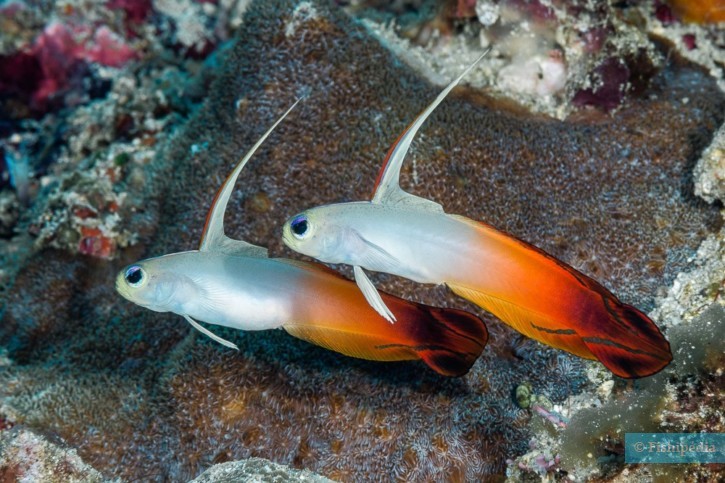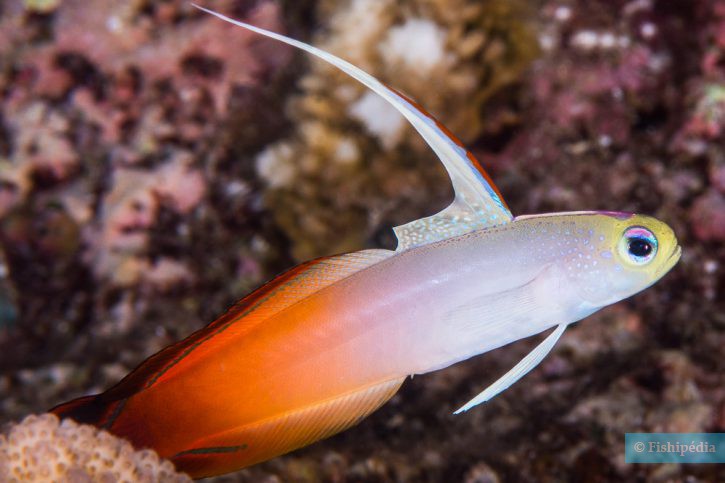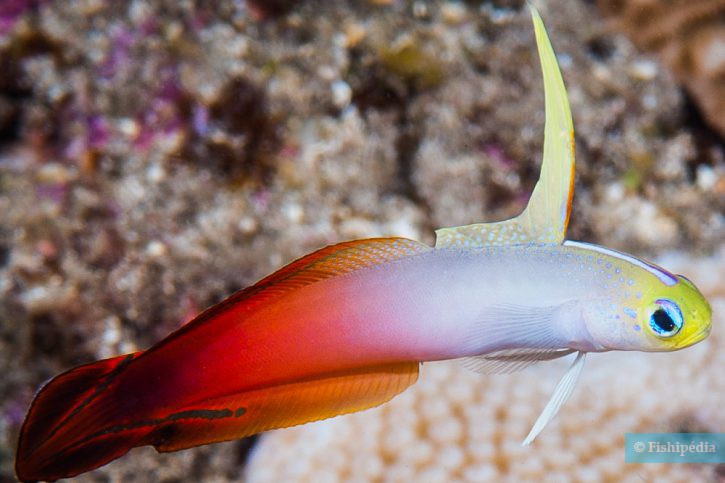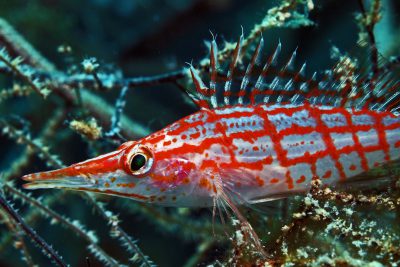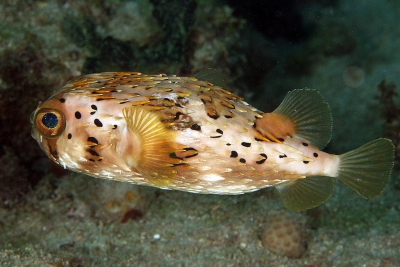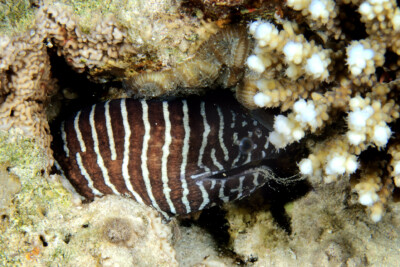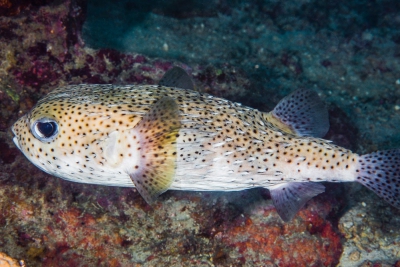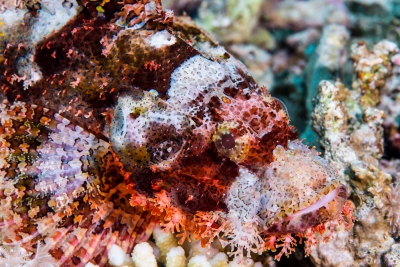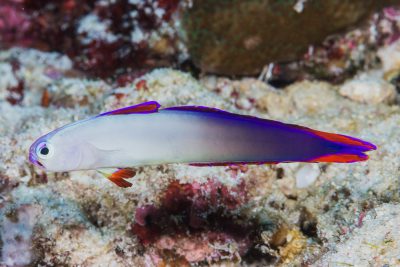fire goby
| Scientific name | Nemateleotris magnifica |
|---|---|
| Descriptor | Fowler |
| Year of description | 1938 |
| IUCN category (World) | LC |
| Family | Ptereleotridae |
| Genus | Nemateleotris |
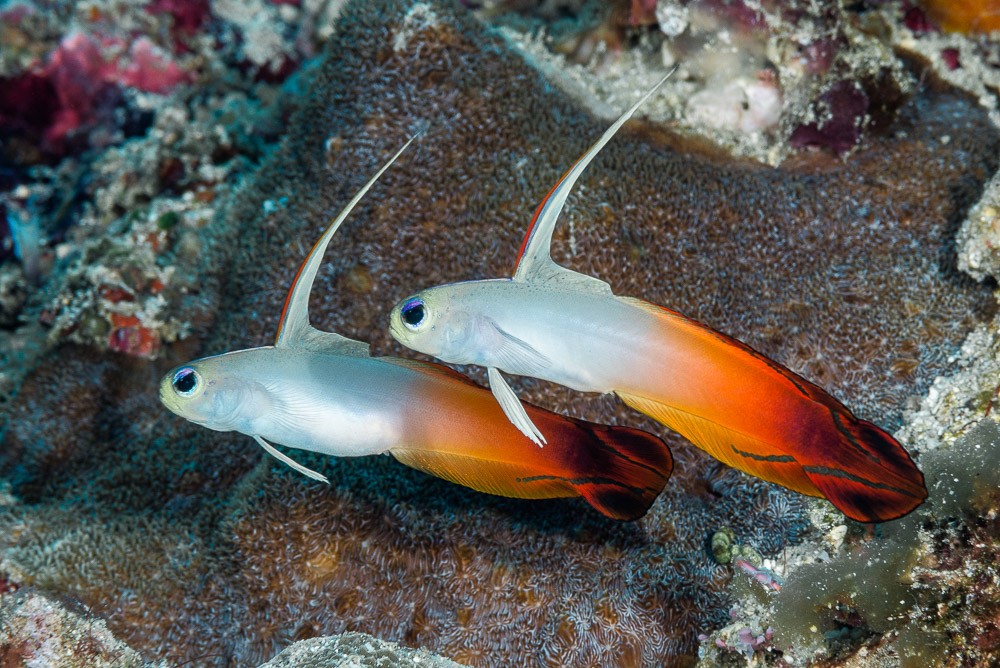

Introduction
Nemateleotris magnifica, commonly known as the fire goby, is a tropical fish found in the Indo-Pacific region. Despite being called the fire goby, it does not belong to the goby family. It can also be referred to as magnificent dartfish or magnificent firefish.
Who is it?
Morphology
-
Average size6 cm
-
Maximum size8 cm
-
Longevity15 year
-
Average size6 cm
-
Maximum size8 cm
-
Longevity15 year
How to recognize This fish ?
This species is easily recognizable due to its coloration. Bicolor, with half of the body being silver-white and the other red, becoming increasingly vivid towards the rear.
The first dorsal fin is greatly elongated and erect when the species does not feel threatened.
Sexual dimorphism
Dimorphism is not visible to the naked eye.
Behaviour & Life cycle
-
dietomnivorous with carnivorous tendency
-
Sociabilityliving as a couple
-
territorialYes
-
Way of livingdiurnal
As adults, the fire goby lives in pairs in small burrows they dig. They are shy species that spend their time suspended near their refuge, hunting zooplankton. Juveniles live in small groups.
Territorial, this fish can become aggressive on certain occasions. It does not appreciate the presence of other species in its territory, especially gobies and blennies, as well as its own kind.
Reproduction
-
Reproductionovipare qui pond sur substrat caché
The fire goby is an oviparous fish that lays eggs in its burrow. The male guards the eggs until they hatch.
Harmless species
This species does not represent any particular threats to humans when encountered in its natural environment.
Origin and distribution

What is its habitat?
Natural environment characteristics
-
Temperature23 - 27 °C
-
Depth6 - 30 m
Biotope presentation
The fire goby is most commonly found at depths less than 30m. However, it is not uncommon to find this fish at other depths. They are often seen in small sandy areas and at the base of drop-offs.
Species of the same biotope
Main recommendations for fishkeeping
Deontology
In order to preserve wildlife, if you acquire this animal, it must not be released into the wild. See also, the Fishipedia charter.
Fishipedia supports the practice of responsible and environmentally friendly aquarium keeping. We encourage maintenance if it is motivated by a desire to understand the biological functioning of living things and if it is done with respect for animal life.
We believe that aquaristics is an opening to the discovery of aquatic environments, especially freshwater, and that this knowledge is necessary to better protect and respect these environments. Logically, we refute the compulsive purchase of animals that would not find a sufficient and / or adapted place in the host aquarium.
Our recommendationsThese tips apply to adult species from breeding. With regards to water conditions, wild species or close relatives must be kept under the same conditions as in their area of origin.
-
Min volume200 liters
-
Population min2
-
Temperature23 - 27 °C
-
pH (acidity)8.2 - 8.4
CharacteristicsThe characteristics below apply for adult species. They correspond to an average of cases, validated in maintenance condition.
-
Difficulty breedingThe farming difficulty is relative. It depends on experiments already carried out with similar species. First, it takes into consideration the robustness of the species, the ease of recreation of a favorable environment and the general behaviour with the other inhabitants of the aquarium.hard
-
Robustnesssensible
-
Behaviourslightly aggressive
-
Availabilitystandard
General reminders
It is strongly advised to read the complete dedicated file and to get information on the feedbacks of maintenance of the envisaged animal, this to avoid any potential conflict whose end result is generally the death of the individual (or the other inhabitants). It is important not to overload your aquarium to limit pollution. This will make maintenance easier.
General reminder on maintenance datas
Le démarrage d'un aquarium est une partie primordiale pour l'équilibre et le bien-être des poissons. Lorsque l'on met en eau un aquarium, l'eau passe naturellement par un cycle biologique : le cycle de l'azote. Celui-ci dure environ trois semaines. Tous les 2 jours, nous vous conseillons de tester votre eau jusqu'à ce que le taux de nitrite soit à zéro pendant plusieurs jours d'affilée.
Pour accélérer ce cycle, vous pouvez utiliser un activateur de bactéries comme JBL Denitrol. Cette solution riche en bactéries vivantes et enzymes permet une mise en place rapide du cycle de l'azote. Les poissons peuvent alors être introduits plus rapidement.
Il est important de tester l'eau de son aquarium régulièrement pour maintenir un environnement sain pour les poissons et les autres habitants. Les tests d'eau permettent de mesurer les niveaux de différents paramètres tels que le pH, la dureté totale, ainsi que les taux de nitrates, de nitrites et d'ammoniaque.
Pour réaliser ces tests, vous pouvez utiliser des produits d'analyse spécialisés tels que JBL ProScan qui permet de réaliser un diagnostic de l'eau directement via un smartphone. Il existe également des coffrets de tests plus classiques de bandelettes, comme JBL PROAQUATEST.
En cas d’usage de l’eau du robinet, vous pouvez utiliser un conditionneur d’eau de type Biotopol de JBL pour éliminer les substances nocives comme le chlore, le cuivre, le plomb et le zinc. Les conditionneurs d'eau garantissent une meilleure santé aux poissons et une meilleure croissance des plantes.
Chlorine and chloramine are dangerous for the health of animals. Used to disinfect water, these agents are present in significant quantities in tap water. We recommend using an anti-chlorine agent every time you change the water. In addition to chlorine, treatments and medicines sold for aquarium use sometimes contain dangerous heavy metals in high doses.
Specific needs for the fire goby
The fire goby is a marine species which lives naturally at a temperature between 23 °C and 27 °C. For proper maintenance, the temperature should never exceed the 30°C for long periods. The fire goby is sensitive to abrupt changes in parameters as well as to chemicals. Its acclimation in an aquarium must be done with special care to prevent it from developing diseases or weaknesses. Nitrate levels should remain below 25mg/L. To keep the water clean and unpolluted, plan on changing 20% to 30% of the water volume each month. In seawater, it is also possible to remove nitrates using one of the following methods: Jaubert, denitrator on sulfur, biopeletts, vodka method.
The fire goby is a species whose maintenance is rather reserved for informed aquarists . It can only be successfully carried out by carrying out a minimum of documentation work. Special husbandry conditions can easily lead to the death of the species or other animals.
Jumping fish
Be careful, the fire goby is an excellent jumper, naturally using this faculty to change its living area or to escape from predators. The aquarium must be perfectly covered to prevent him from making a deadly jump...
Builder fish
This fish has the particularity to dig its territory in the sand. Therefore, it is likely to uproot plants and modify the decor of the aquarium.
Cohabitation & Environment
In a community aquarium context, this species should be kept in a minimum volume of 200 liters.
The fire goby may show signs of aggression. In general, this species should not be mixed with large territorial species or other overly aggressive species, in order to avoid possible stress or even injury.
However, it can coexist with other species with a peaceful temperament and with some slightly territorial neighbors, as far as the volume of the aquarium allows. It is important to avoid that two territorial species share the same living area in an aquarium of insufficient volume.
Tips for feeding
The fire goby is omnivorous with carnivorous tendency.
You should not overfeed your residents to avoid polluting the water. For most species, it is better to feed a few small portions each day rather than one large meal.
Reproduction protocol
-
Maintenance difficultyvery hard
-
egg-laying protectionYes
Hybridization risks
In general, it is advised not to mix several species of the same genus or different varieties of the same species, to avoid the risks of hybridization.
These animals might interest you
To go further
Sources & Contributions
Participation & Validation
The Fishipedia team and specialist contributors are committed to providing high-quality content. However, although the information comes from scientific sources or testimonials from specialists, the cards may contain inaccuracies.

Benoit Chartrer

Adrien Falzon
Translation
Translation done with the valuable contribution of our translators, who make this information available to a wider audience. We sincerely thank them for their commitment.
Scientific partners
Tags
Same genus
Species of the same biotope
